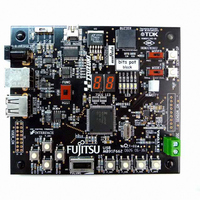USB-100 Fujitsu Semiconductor America Inc, USB-100 Datasheet - Page 56

USB-100
Manufacturer Part Number
USB-100
Description
KIT STARTER FOR USB
Manufacturer
Fujitsu Semiconductor America Inc
Type
MCUr
Datasheet
1.USB-100.pdf
(143 pages)
Specifications of USB-100
Contents
Board, Cable
For Use With/related Products
MB91F662
Lead Free Status / RoHS Status
Lead free / RoHS Compliant
Other names
865-1108
- Current page: 56 of 143
- Download datasheet (7Mb)
4
4.1
peripherals interface for next-generation PCs. This led to their release of the first USB 1.0
specifications (standards) in 1996. USB 1.1 was released in 1998 and USB 2.0 was released in
2000. For many years, the RS-232C and printer ports served as the main interface for
connecting peripherals to a PC. The problem with these legacy interfaces was that they were
limited to low transfer rates, allowed only one device to be connected per port, and thus required
an increase in ports to connect more devices.
separate ports for the keyboard, mouse, and display. The USB was developed to consolidate
these interfaces into a single connector that would allow connection of various peripherals.
4.2
PC peripherals and communicate between embedded devices.
the proper driver when it is plugged in to the PC.
PC power still on. That is, the PC power does not have to be turned off or rebooted during or
after the device is plugged or unplugged.
this is referred to as "Self-powered".)
(host), and data is exchanged between the peripheral and the host. Peripherals cannot transfer
data directly to another host. Furthermore, a peripheral cannot request a data transfer to the host.
The peripheral must perform data transfers at the request of the host. Because there is only one
The USB has these features.
USB stands for Universal Serial Bus.
In 1993, engineers from Compaq, Intel, Microsoft, and NEC gathered and jointly developed a
This lead to an extensive array of connectors occupying the rear panels of PCs, including
1. Ease of use
USB supports Plug-and-play and Hot Swapping, and Bus Power, making it easy to expand
Plug-and-play refers to the mechanism for automatically recognizing a device and installing
Hot Swapping is a general reference to the ability of plugging or unplugging devices with the
Bus Power refers to the standard for supplying from the PC via the cable. (The opposite of
2. Single master system
USB follows the single master system for transferring data.
We will explain using the PC as an example. The peripherals to a PC are controlled by the PC
What is a USB?
What is a USB?
Features of the USB
55
Related parts for USB-100
Image
Part Number
Description
Manufacturer
Datasheet
Request
R

Part Number:
Description:
IC POWER SUPPLY MONITOR 8SOP
Manufacturer:
Fujitsu Semiconductor America Inc
Datasheet:

Part Number:
Description:
IC POWER SUPPLY MONITOR 8SOP
Manufacturer:
Fujitsu Semiconductor America Inc
Datasheet:

Part Number:
Description:
IC MCU 60K FLASH 2KB RAM 52LQFP
Manufacturer:
Fujitsu Semiconductor America Inc
Datasheet:

Part Number:
Description:
IC MCU 32BIT 256KB FLASH 120LQFP
Manufacturer:
Fujitsu Semiconductor America Inc
Datasheet:

Part Number:
Description:
IC CTLR TOUCH SENSOR 12CH 30SSOP
Manufacturer:
Fujitsu Semiconductor America Inc
Datasheet:

Part Number:
Description:
IC CTLR TOUCH SENSOR 12CH 40QFN
Manufacturer:
Fujitsu Semiconductor America Inc
Datasheet:

Part Number:
Description:
SYNTHESIZER PLL DUAL INP 20SSOP
Manufacturer:
Fujitsu Semiconductor America Inc
Datasheet:

Part Number:
Description:
SYNTHESZR PLL 1.1GHZ DUAL 16SSOP
Manufacturer:
Fujitsu Semiconductor America Inc
Datasheet:

Part Number:
Description:
IC SSCG EMI RED 8-SOIC
Manufacturer:
Fujitsu Semiconductor America Inc
Datasheet:

Part Number:
Description:
IC SSCG EMI RED 8-TSSOP
Manufacturer:
Fujitsu Semiconductor America Inc
Datasheet:

Part Number:
Description:
IC SSCG EMI RED 8-SOP
Manufacturer:
Fujitsu Semiconductor America Inc
Datasheet:

Part Number:
Description:
SYNTHESIZER PLL 2.5GHZ 16SSOP
Manufacturer:
Fujitsu Semiconductor America Inc
Datasheet:

Part Number:
Description:
SYNTHESIZER PLL 1.2GHZ 16SSOP
Manufacturer:
Fujitsu Semiconductor America Inc
Datasheet:

Part Number:
Description:
SYNTHESIZER PLL 2.5GHZ 16BCC
Manufacturer:
Fujitsu Semiconductor America Inc
Datasheet:

Part Number:
Description:
IC SSCG EMI RED 8-SOP
Manufacturer:
Fujitsu Semiconductor America Inc
Datasheet:










